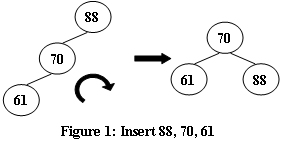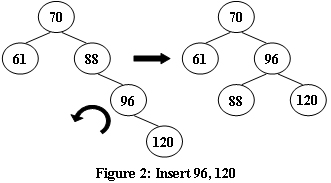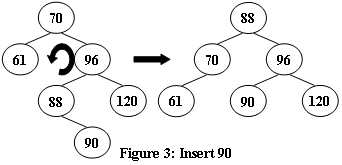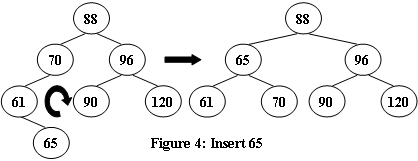An AVL tree is a self-balancing binary search tree. In an AVL tree, the heights of the two child subtrees of any node differ by at most one; if at any time they differ by more than one, rebalancing is done to restore this property. Figures 1-4 illustrate the rotation rules.



Now given a sequence of insertions, you are supposed to tell the root of the resulting AVL tree.
Input Specification:
Each input file contains one test case. For each case, the first line contains a positive integer N (≤) which is the total number of keys to be inserted. Then Ndistinct integer keys are given in the next line. All the numbers in a line are separated by a space.
Output Specification:
For each test case, print the root of the resulting AVL tree in one line.
Sample Input 1:
5
88 70 61 96 120
Sample Output 1:
70
Sample Input 2:
7
88 70 61 96 120 90 65
Sample Output 2:
88#include<cstdio> #include<algorithm> using namespace std; struct Node{ int v; int height; Node* lchild; Node* rchild; }*root; int getHeight(Node* root); void updateHeight(Node* root); int getBalanceFactor(Node* root); Node* NewNode(int v); void Insert(Node* &root, int v); void L(Node* &root); void R(Node* &root); int main(){ int n,v; scanf("%d",&n); for(int i = 0; i < n; i++){ scanf("%d",&v); Insert(root,v); } printf("%d",root->v); return 0; } void Insert(Node* &root, int v){ if(root == NULL){ root = NewNode(v); return; } if(root->v > v){ Insert(root->lchild,v); updateHeight(root); if(getBalanceFactor(root) == 2){ if(getBalanceFactor(root->lchild) == 1){ R(root); }else if(getBalanceFactor(root->lchild) == -1){ L(root->lchild); R(root); } } }else{ Insert(root->rchild,v); updateHeight(root); if(getBalanceFactor(root) == -2){ if(getBalanceFactor(root->rchild) == -1){ L(root); }else if(getBalanceFactor(root->rchild) == 1){ R(root->rchild); L(root); } } } } Node* NewNode(int v){ Node* node = new Node; node->v = v; node->lchild = node->rchild = NULL; node->height = 1; return node; } void updateHeight(Node* root){ root->height = max(getHeight(root->lchild),getHeight(root->rchild))+1; } int getHeight(Node* root){ if(root == NULL) return 0; return root->height; } int getBalanceFactor(Node* root){ return getHeight(root->lchild) - getHeight(root->rchild); } void L(Node* &root){ Node* temp = root->rchild; root->rchild = temp->lchild; temp->lchild = root; updateHeight(root); updateHeight(temp); root = temp; } void R(Node* &root){ Node* temp = root->lchild; root->lchild = temp->rchild; temp->rchild = root; updateHeight(root); updateHeight(temp); root = temp; }
